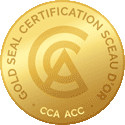
Fall Protection Online Certification Training

Description
Our fall protection course includes special modules for Alberta and British Columbia. These modules follow occupational health and safety regulations.
If you work in Alberta, consider taking the Online Fall Protection Alberta course to cover Alberta’s legislative requirements.
If you work in British Columbia, consider taking the Online Fall Protection British Columbia course to cover British Columbia’s legislative requirements.
Course Highlights:
Gold Seal Eligibility: This course is eligible for 1 Gold Seal Certification Credit from the Canadian Construction Association.
Interactive Learning: Engaging 3D animated scenarios and real-world examples bring concepts to life.
Cover Key Fall Protection Systems: Learn how to use fall restraint, fall arrest systems, and personal fall protection equipment. Explore anchor points, safety nets, and more.
Flexible and Accessible: Mobile and tablet compatible, self-paced, and accessible 24/7.
Industry-Recognized Certification: Receive same-day, fall protection certification with a printable, non-transferable certificate and Digital Badge. This certification is valid for three years.
Practical Evaluation Tools: The course provides practical evaluation tools and guides for supervisors to assess and sign-off on workers’ competency.
Reliable Resources: Access to a glossary and toolbox of resources for continued reference, promoting safety awareness and preventing any risk of injury.

Course Outline
Overview of the course structure, navigation, and purpose. Introduces fall protection concepts, emphasizing the importance of safety training to reduce workplace injuries and fatalities. Outlines the components of the course, including quizzes, videos, and practical assessments.
Explores the definition and importance of fall protection, legal requirements, and stakeholder roles. Highlights worker rights, safety culture principles, and introduces fall protection plans.
Details the different types of fall protection systems, including travel restraint, fall arrest, and fall restrict systems. Explains the components of each system, their appropriate applications, and maintenance practices to ensure worker safety. Covers how to inspect, don, safely use, and doff the fall protection equipment for these systems, from full-body harnesses to lanyards and energy absorbers.
Focuses on preventive measures such as guardrails, bump lines, safety nets, and warning signs. Explains installation requirements, usage scenarios, and effectiveness in preventing falls from heights.
Explores the safe use of ladders, scaffolds, and mobile elevating work platforms (MEWPs). Discusses inspection requirements, fall protection integration, and the proper selection of equipment based on the task and work environment.
Identifies common fall hazards such as unprotected edges and slippery surfaces. Includes strategies for hazard recognition, suspension trauma mitigation, and risk control measures.
Covers hazard assessments, the R.A.C.E methodology (Recognize, Assess, Control and Evaluation of hazards), and the hierarchy of controls for fall protection. Features detailed guidance on how to calculate fall clearance to ensure adequate system set-up. This prevents workers from falling. Highlights the integration of fall protection plans into overall hazard management.
Details the creation of fall rescue plans, including self-rescue, assisted rescue, and mechanical rescue methods. Explains suspension trauma risks, rescue equipment, and communication protocols for effective emergency responses.
To get a certificate of completion from our fall protection online course, learners need to score at least 80%. You have two attempts to successfully pass the final exam.
Who Should Enroll?
Workers performing tasks at elevation
Foremen, supervisors, and health & safety officers
A competent person overseeing compliance with fall protection measures
Employers needing to meet health and safety training requirements
Frequently Asked Questions
A self‑paced, interactive online training course teaching fall arrest, restraint, rescue planning, and fall hazard management. Upon completion, practical evaluation guides and tools are provided for competency sign-off on tasks such as donning, doffing, and inspecting equipment, use of travel arrest and travel restraint equipment, and the safe use of ladders.
Is this Online Fall Protection course recognized across Canada?
Absolutely! This training meets national and provincial standards, including specialized modules for Alberta and British Columbia. However, this training is not approved to Ontario MLITSD WAH or WorkplaceNL standards.
How long does this fall protection course take?
Approximately 3 hours and 30 minutes, including the final exam.
Am I completing fall arrest training online?
Yes—this online course thoroughly teaches fall arrest, restraint systems, and safety practices.
Is the fall protection certification valid?
Yes—obtain instant certification with a printable or digital badge. Certification is valid for 3 years.
What if I fail the final exam?
You have up to two attempts to pass the final exam with a required minimum score of 80%.
How long does my Fall Protection certification last?
Your Fall Protection certification is valid for 3 years after completion, at which point you'll need to renew.
Do you offer bulk discounts?
Yes! We provide great discounts for bulk orders to help train your entire team with confidence. Our enterprise solutions make it easy to share training, track progress, and send reminders for certification renewals. Keep your employees trained with ease and efficiency. Call us toll-free at 1-800-465-3366 or email sales@danatec.com to learn more.